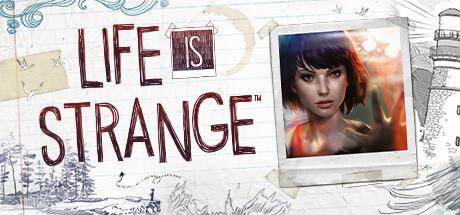Life is Strange is an episodic adventure and mystery game, where players uncover mysteries and use their ability to manipulate time to create different outcomes in the game. This single player game was released in January of 2015, and was published by Square Enix. Life is Strange’s narrative follows the story of Max Caulfield, a photography student, who discovers her ability to rewind time, as she navigates her school environment and her goal to save her best friend Chloe. In this game, players are presented with various choices that can alter their game flow, and must investigate their setting to uncover clues and solve mysteries. This game is targeted towards players 16+ due to its maturity in themes, such as gun violence and suicide. This game is available on multiple platforms, such as the Nintendo Switch, Playstation 4 and 5, Android, Playstation, and PC (on Steam). In Life is Strange, mechanics such as exploration, item inspection, and character interaction allows players to make discoveries and unravel the mysteries about the world around them. Furthermore, these abilities allow players to explore the settings they are in, ultimately unlocking clues about the world that they find themselves in. In addition, this game awards players the ability to rewind time, allowing the narrative to enter loops of events where players can change their decisions to ultimately spin the narrative into entirely different story branches.
Life is Strange utilizes free-roam exploration, item inspection, and character interactions that allow players to get a better understanding of the game’s narrative and uncover its mysteries. When I initially start in Life is Strange Episode 1, I was launched onto a mysterious island with a huge tornado forming, as seen below.
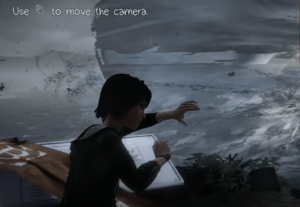
I was given the instruction to use my mouse to move the camera, and I was essentially allowed to free roam this part of the island. I moved around to try to better understand what was happening, and Max’s inner dialogue told me to go to the lighthouse, which I proceeded to do. From there, a cut scene started, as seen below, which allowed me to gain a better understanding of the narrative. Hence, in Life is Strange, exploration and walking is used directly to move along the narrative and directly introduce the plot.
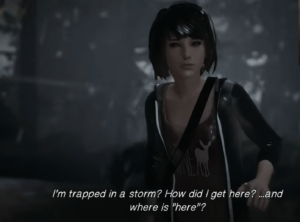
Upon going through this cutscene, I was transported to a classroom, where I was now given the ability to inspect objects, as seen below.

Pressing the “Look” button allowed me to look more closely at the Polaroid, for example, and figure out that Max, the character I was playing as, was very interested in photography.

This game mechanic of inspecting objects proved to be very important in helping to piece together the mysteries of the game, as seen above. Being able to see the missing poster closely allowed me to understand that there is something perhaps more sinister to the school that Max is attending than meets the eye. Another similar game mechanic was being able to “inspect” different characters in the scene, where I was given the choice to talk to the character or look at them, as seen below.

Being able to converse with different characters allowed me to gain a better understanding of Max, her relationship to those around her, as well as their relationship to each other. For example, as seen below, Max’s interaction with her professor allowed me to realize that she is not the best student, and doesn’t seem to prioritize her photography class as much as her professor would like her to.

One additional key mechanic that allows players to better understand the mysteries woven into the narrative is the ability to access Max’s diary, as seen below.
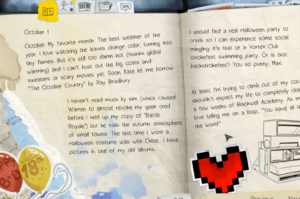
This, above all else, helped me to gain a better understanding of Max’s personality, as well as her relationships with her peers. This diary even contained detailed briefings about some of her peers and how she felt about each of them. This specific mechanic was something that set this game apart from other mystery first person games that I’ve played. Typically, players are only able to understand the character they’re playing better through direct interactions with other players or through cutscenes; a direct way of learning more about the character such as through the perspective of a teenage diary was definitely pivotal in my understanding of Max, and allowed me to better ground the game’s narrative. Ultimately, these game mechanics such as free exploration, inspecting objects and players, as well as having access to personal items allowed me to slowly uncover the mysteries woven into this narrative.
Using the aforementioned game mechanics, players in Life is Strange are able to explore the settings that they are in that helps to control and progress the story. Due to the free-roaming ability, I was able to explore school that Max was in better; the high school hall setting allowed me lots of room to explore and learn more about the school’s students, as seen below.

Furthermore, the setting was constructed in such a way that I was able to access this bathroom seen below, which I continued exploring as Max.
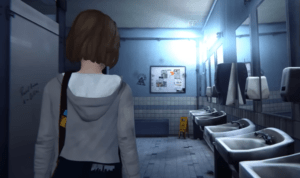
Being in this bathroom specifically allowed the story to progress dramatically; here, Max witnesses one of her peers fatally shoot one of her classmates and ultimately activates her time rewinding abilities. Hence, the architecture of the setting is specifically constructed to help players progress through the narrative amidst their exploration and need to solve the mystery at hand. This architecture of the setting is quite similar to other games of this genre such as the Quarry, where players are specifically led to certain parts of the setting to force the game’s narrative forward. However, in Life is Strange, unlike other games in its genre, did not give a specific objective to the player. Usually, players are given some objective to accomplish within the story to progress in the story, but in this game, I explored simply to explore without being influenced by the game in any way. Hence, the setting is cleverly constructed to allow players to progress through the game’s narrative without being given a specific objective, at least in the beginning of the game.
Ultimately, Life is Strange, Episode 1, creates a story arc, while simultaneously using loops through Max’s ability to rewind time. Within Episode 1, players discover that Max has the ability to go back in time, as seen below:


When players rewind time, they go back to previous events and are therefore able to make decisions based on what they saw in the future. This ultimately creates a loop where players are repeating interactions or actions that they have already done. However, since both Max and the player retains their memory, they can make new decisions that ultimately moves the story arc forward. For example, using this ability, Max is able to save her classmate from getting shot and moves the story forward, but does so using by going through a loop of events she has already witnessed. Hence, this ability is quite unique to this game, whereas in similar games like Until Dawn, although players are aware that their decisions can affect game outcomes, it’s unclear how exactly they affect outcomes. Here, through Max’s rewind ability, players can directly see what outcomes come of their actions, and are even given the chance to change undesirable outcomes. Consequently, Max’s unique rewind ability creates loops in this gameplay, while simultaneously moving the story arc forward.
Overall, Life is Strange uses game mechanics such as exploration and inspection to allow players to traverse through both the setting and the game’s narrative. I had an enjoyable experience playing the game, which seemed to prioritize player curiosity to uncover more about the game. One critique I had of the game (in the 1 hour timeslot that I played it) is the limited choice of dialogue that I was given when speaking with characters. For example, when I was talking with the professor, I was forced between saying two different, slightly disrespectful things to the professor. Although it was because this is Max’s personality, my choices felt very constrained since there were only two possibilities for that conversation. Furthermore, although I appreciated that this game prioritized player curiosity, I, being a very thorough player, was afraid I was going to miss something important, so it took me a very long time to even get to the bathroom. Some overall hints or indications about what player’s should be doing would be helpful, and would help speed up gameplay for player’s who are not as interested in exploration as they are in the narrative itself. Ultimately, Life is Strange functions as an effective mystery, narrative game that uses various game mechanics to tell an interesting and engaging story.


